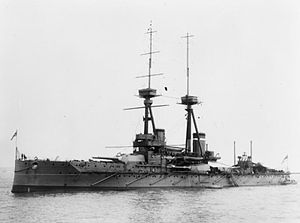 Collingwood at anchor, 1912
| |
| History | |
|---|---|
| Name | Collingwood |
| Namesake | Vice-Admiral Cuthbert Collingwood, 1st Baron Collingwood |
| Ordered | 26 October 1907 |
| Builder | Devonport Royal Dockyard |
| Laid down | 3 February 1908 |
| Launched | 7 November 1908 |
| Commissioned | 19 April 1910 |
| Fate | Sold for scrap, 12 December 1922 |
| General characteristics (as built) | |
| Class and type | St Vincent-class dreadnought battleship |
| Displacement | 19,700 long tons (20,000 t) (normal) |
| Length | 536 ft (163.4 m) (o/a) |
| Beam | 84 ft 2 in (25.7 m) |
| Draught | 28 ft (8.5 m) |
| Installed power |
|
| Propulsion | 4 × shafts; 2 × steam turbine sets |
| Speed | 21 knots (39 km/h; 24 mph) |
| Range | 6,900 nmi (12,800 km; 7,900 mi) at 10 knots (19 km/h; 12 mph) |
| Complement | 758 |
| Armament |
|
| Armour | |
HMS Collingwood was a St Vincent-class dreadnought battleship built for the Royal Navy in the first decade of the 20th century. She spent her whole career assigned to the Home and Grand Fleets and often served as a flagship. Prince Albert (later King George VI) spent several years aboard the ship before and during World War I. At the Battle of Jutland in May 1916, Collingwood was in the middle of the battleline and lightly damaged a German battlecruiser. Other than that battle, and the inconclusive action of 19 August, her service during the war generally consisted of routine patrols and training in the North Sea. The ship was deemed obsolete after the war; she was reduced to reserve and used as a training ship before being sold for scrap in 1922.